Easy Sourdough Fougasse Recipe
An easy sourdough fougasse recipe. It’s baked until golden and topped with coarse salt and herbs de Provence. The bread can be made in one day or overnight for a long ferment. It makes one large fougasse.
Fougasse is a French flatbread that originates from the Southern region of Provence. It’s a bread that originates far back, from in ancient Rome when the bread panis focacius was baked.
This bread went on to have many derivatives including the Italian focaccia, the hogaza in Spain, pogácsa in the Balkans, and the fougasse (fogazta) in France.
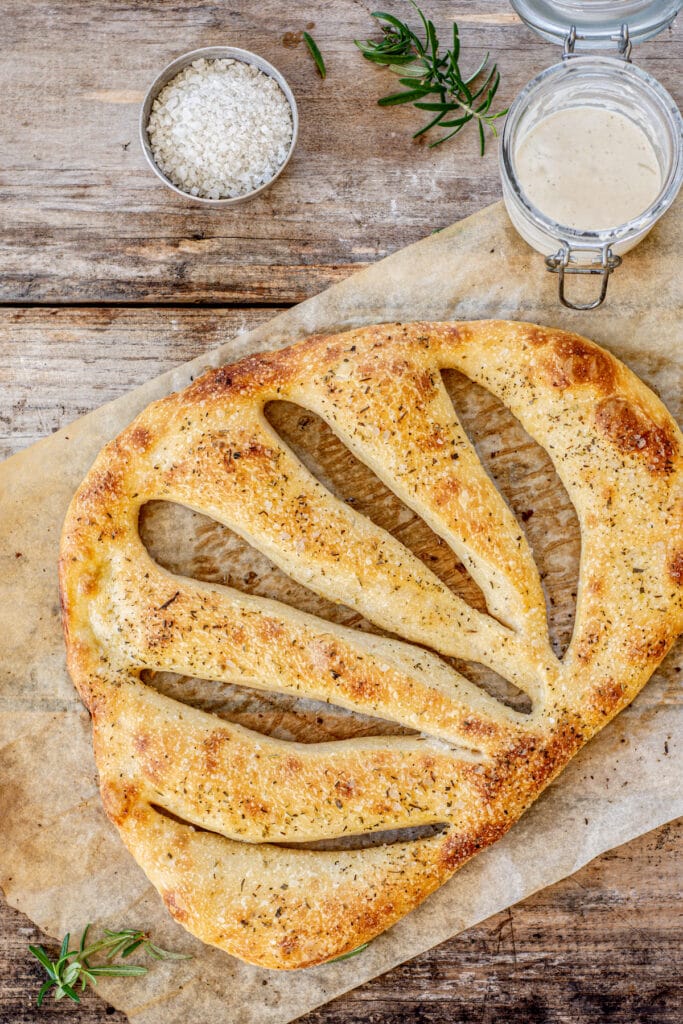
Fougasse
A fougasse has an iconic shape which is how it differentiates from other bread. It’s shaped like a flatbread with slashes in the middle which is said to resemble ears of wheat.
The dough is sometimes filled before baking, like a calzone, or ingredients are added to the dough itself.
Fougasse can be sprinkled with herbs, oil, and salt before baking or simply baked plain. It makes a great pull apart sharing bread, to serve with cheese or dipped into good quality olive oil.
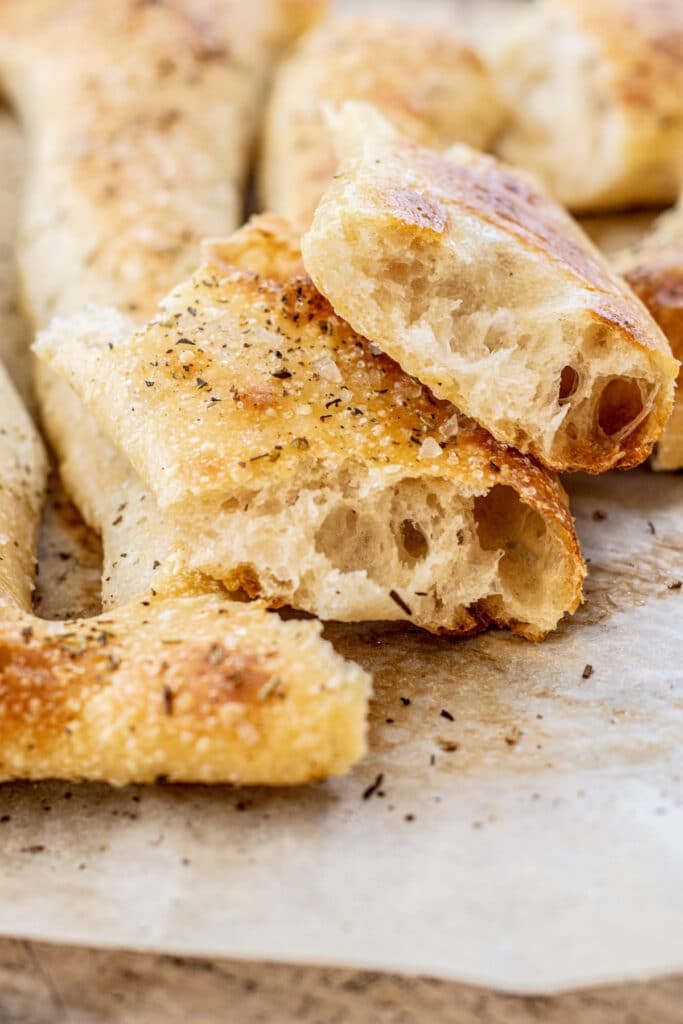
Sourdough fougasse
This sourdough fougasse has extra flavour brought to the dough through the use of a sourdough starter. The sourdough bread dough can be made and baked all in one day (not including the feeding of the starter), or over two days.
If baking over two days, the dough is first cold fermented in the fridge overnight before being shaped the following day. This imparts more flavour to the dough. The long bulk fermentation also helps to break down the starches in the flour more, which can aid with digestibility.
It’s similar to this sourdough focaccia recipe in the sense that it uses olive oil and toppings. However, it is a thicker dough than sourdough focaccia, with lower hydration. This is because the dough is baked as a stand-alone bread so it needs to hold its shape without help, whereas the focaccia is baked in a pan with borders.
The ingredients
For the fougasse, you will need –
- Strong flour. It can be a strong all-purpose white flour or bread flour. One with a protein level of at least 11%. You can also substitute around 30% of the white flour with whole wheat flour. This will give a slightly dense crumb.
- 100% hydration starter
- Water
- Olive oil
- Salt
- Toppings of your choice – This recipe uses dried herbs de Provence, coarse sea salt, olive oil
Herbs de Provence
This is a mixture of french herbs, You can buy it pre-mixed or make your own. It uses a mixture of some or all these herbs such as dried tarragon, thyme, parsley, rosemary, marjoram, and oregano.
It’s similar to an Italian herb mix so you can use that instead if you like.
Baker’s schedule
Here is a baker’s schedule with two options to outline the process involved. The exact timings can be tweaked to suit your own schedule.
Same day sourdough fougasse will have a more subtle sourdough tang. The flavour profile of the fougasse is increased with an overnight ferment.
Option 1 – Same day dough (not including starter feeding)
- The night before – feed sourdough starter
- 8:30 am – Mix the flour and water for the dough and autolyze for 30 minutes.
- 9:00 am – Add in the ripe sourdough starter, salt, and oil and mix it together into a sticky dough. Stretch and fold every 30 minutes for 2 hours. Let the dough sit for another 1-2 hours until bulked out by around 40-50% and is showing signs of fermentation (air bubbles will form.)
- 1 pm – Pre-shape the dough into a round and leave it to sit for 30 minutes.
- 1:30 pm – Shape the fougasse, then let it rise in a warm spot for approximately 1-2 hours until sightly puffy. The timing of this will depend on your room temperature.
- 3 pm – Brush the top of the dough with olive oil and sprinkle with toppings. Bake.
Option 2 – Overnight cold ferment
- 10 am – feed sourdough starter
- 3:30 pm – Mix the flour and water for the dough and autolyze for 30 minutes.
- 4:00 pm – Add in the ripe sourdough starter, salt, and oil and mix it together into a sticky dough. Stretch and fold every 30 minutes for 2 hours. Let the dough sit for another 1-2 hours until bulked out by around 40% and is showing signs of fermentation.
- 8 pm – Cover the dough and place it in the refrigerator overnight.
- 9 am the following day – Preshape the cold dough into a round and leave it to sit for 30 minutes.
- 9:30 am – Shape the fougasse, then let it rise in a warm spot for approximately 1-2 hours until slightly puffy. The timing of this will depend on your room temperature.
- 11:30 am – Brush the top of the dough with olive oil and sprinkle with toppings. Bake.
Feeding a sourdough starter
If feeding the starter the night before, use a ratio of 1:3:3 or 1:4:4 if your kitchen is warm. A 1:3:3 ratio means 1 part starter, 3 parts flour, and. 3 parts water, all measured in weight. If feeding the starter in the day, you can use a 1:2:2 ratio.
The more flour and water added the slower the starter will rise. For an overnight rise, you don’t want the starter peaking too early and collapsing.
The starter can be used once it has at least doubled, if not tripled. Do use it before it peaks and collapses.
Step by step
Starter
Begin by mixing your sourdough starter. Mix together the starter, flour, and water in a bowl until well-combined.
Tip it into a clean jar and mark the line where the starter comes up to. This way you can easily tell when it has doubled or tripled.
Dough
In a large bowl, mix together the flour and water for the fougasse dough using a fork or your hands. Mix it into a shaggy dough. Leave it to autolyze for around 30 minutes.
Add in the ripe sourdough starter, salt, and oil, and use wet hands or a fork to combine it into a sticky dough. Over the next two hours, perform a series of stretch and fold the dough every 30 minutes to give it strength.
Cover the dough bowl with a damp cloth, a lid, or a plate and let the dough proof at a warm room temperature for around 1-2 hours until it has bulked out by about 40-50%.
At this point, the dough can be refrigerated overnight and shaped in the morning, or pre-shaped now.
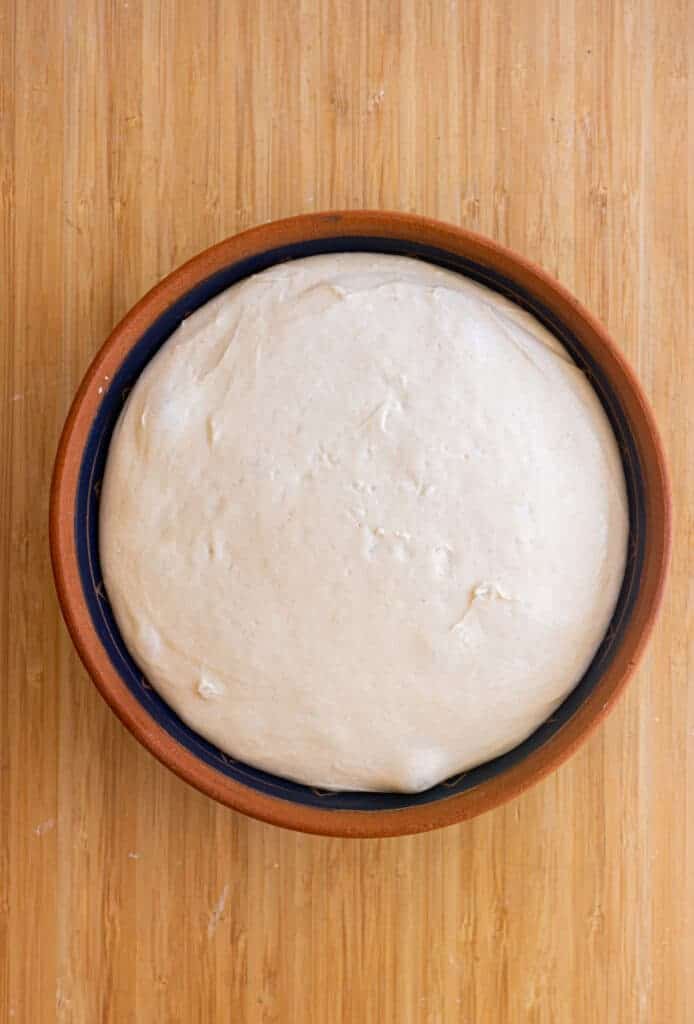
Pre-shape
Pull the dough from the bowl onto a lightly floured work surface. Form it into a round shape and let the dough rest for 30 minutes before shaping.
Shaping
Take a piece of parchment paper and use a pastry brush to brush the sheet with olive oil. Use a bench scraper to scoop up the ball of dough and place it on the oiled baking sheet.
Dust the top with flour, then, using your fingers, gently press the dough into a rectangular shape measuring around 10 inches in length.
With a dough scraper, a sharp knife, or a pair of scissors, make a cut diagonally down the middle of the rectangle, but not all the way to the sides. Make 2-3 more diagonal cuts on each side of the middle cut, again not reaching the edge of the dough completely.
Use oiled hands to gently pull apart the cuts. It makes a sort of leaf shape. Cover the dough with a tea towel and let it rise for 1-2 hours until puffed out.
Preheat the oven and a baking sheet to 220°C/428°F regular oven. Brush the surface area of the dough with plenty of olive oil and sprinkle with dried herbs and coarse salt.

Baking
Transfer the dough and parchment paper to the preheated baking sheet and place it in the oven along with a few ice cubes or a ramekin with a cm of cold water in it to create some steam while the bread bakes.
Bake it until it is a deep golden brown.
The bread will be very crisp when it first comes from the oven but it will soften as it cools.

Serving
This homemade bread is best served on the day it is made. Tear off chunks and dip them in good quality olive oil, or serve it with your favourite dips, cheeses and tapenades.
To serve it on the following days, warm up it in the oven for a few minutes to soften it.
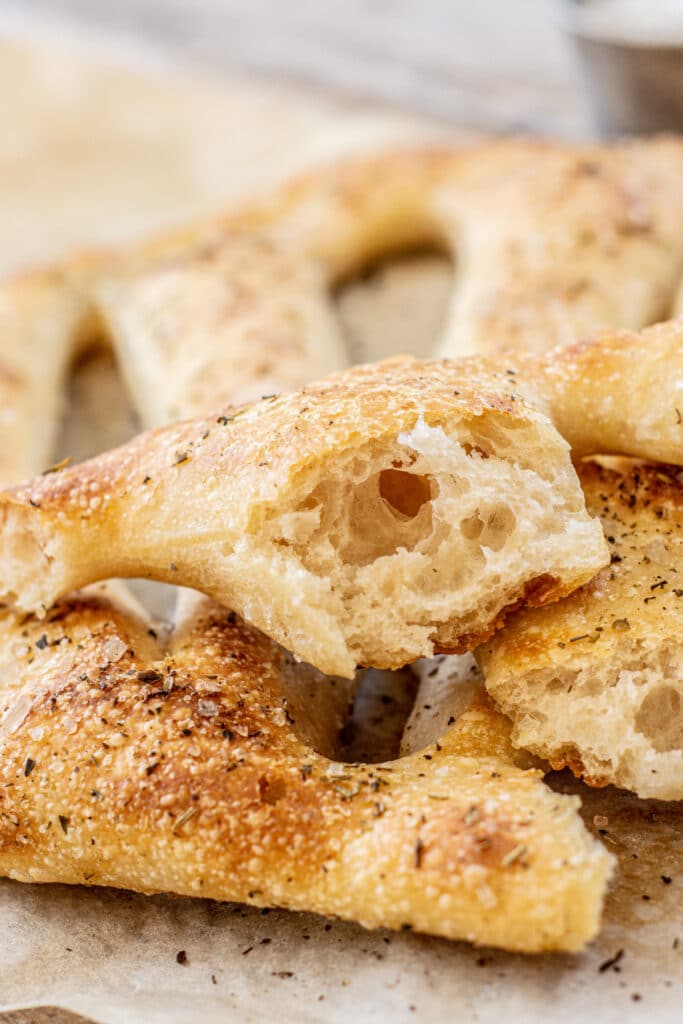
Related recipes
Try these sourdough cinnamon rolls or sourdough pizza dough!

Easy Sourdough Fougasse Recipe
A delicious and easy sourdough fougasse recipe. It's baked until golden and topped with coarse salt and herbs de Provence.
Ingredients
Starter (fed at 1:2:2. Makes approx 100g starter of which 70g will be used)
- 20g starter
- 40g flour
- 40g water
Fougasse
- 300g all-purpose flour or bread flour (with a protein level of at least 11%)
- 210g water
- 70g doubled sourdough starter
- 1 Tablespoon olive oil
- 3/4 teaspoon salt
Toppings
- Olive oil
- Coarse salt
- Dried mixed herbs
Instructions
- Begin by mixing your sourdough starter. Mix together the starter, flour, and water in a bowl until well-combined.
- Tip it into a clean jar and mark the line where the starter comes up to. This way you can easily tell when it has doubled or tripled.
- Once the starter is about ready to use, In a large bowl, mix together the flour and water for the fougasse dough using a fork or your hands. Mix it into a shaggy dough. Leave it to autolyze for around 30 minutes.
- Add in the ripe sourdough starter, salt, and oil, and use wet hands or a fork to combine it into a sticky dough. Over the next two hours, perform a series of stretches and fold the dough every 30 minutes to give it strength.
- After the folds have been completed cover the dough bowl with a damp cloth, a lid, or a plate and let the dough proof at a warm room temperature for a further 1-2 hours until it has bulked out by about 40%.
- Cover the bowl with an airtight cover and refrigerate overnight.
Pre-shape
- Pull the dough from the bowl onto a lightly floured work surface. Form it round and let the dough rest for 30 minutes before shaping.
Shaping
- Take a piece of parchment paper and use a pastry brush to brush the sheet with olive oil. Use a bench scraper to scoop up the ball of dough and place it on the oiled baking sheet.
- Dust the top with flour, then, using your fingers, gently press the dough into a rectangular shape measuring around 10 inches in length.
- With a dough scraper, a sharp knife, or a pair of scissors, cut diagonally down the middle of the rectangle, but not all the way to the sides. Make 2-3 more diagonal cuts on each side of the middle cut, again not reaching the edge of the dough completely.
- Use oiled hands to pull apart the cuts gently. It makes a sort of leaf shape. Cover the dough with a tea towel and let it rise for 1-2 hours until slightly puffed out.
- Preheat the oven and a baking sheet to 220°C/430°F regular oven. Brush the surface area of the dough with plenty of olive oil and sprinkle with dried herbs and coarse salt
- Transfer the dough and parchment paper to the preheated baking sheet and place it in the oven along with a few ice cubes or a ramekin with a cm of cold water in it to create some steam while the bread bakes.
- Bake it for around 20-24 minutes until it is a deep golden brown.
- The bread will be very crisp when it first comes from the oven but it will soften as it cools.
- This homemade bread is best served on the day it is made. Tear off chunks and dip them in good quality olive oil, or serve it with your favourite dips or tapenades.
- To serve it on the following days, warm up it in the oven for a few minutes to soften it.
Recommended Products
As an Amazon Associate, a Mighty Ape affiliate and member of other affiliate programs, I earn from qualifying purchases.
Nutrition Information:
Yield: 8 Serving Size: 1Amount Per Serving: Calories: 263Total Fat: 4gSaturated Fat: 1gTrans Fat: 0gUnsaturated Fat: 3gCholesterol: 0mgSodium: 274mgCarbohydrates: 48gFiber: 2gSugar: 0gProtein: 7g

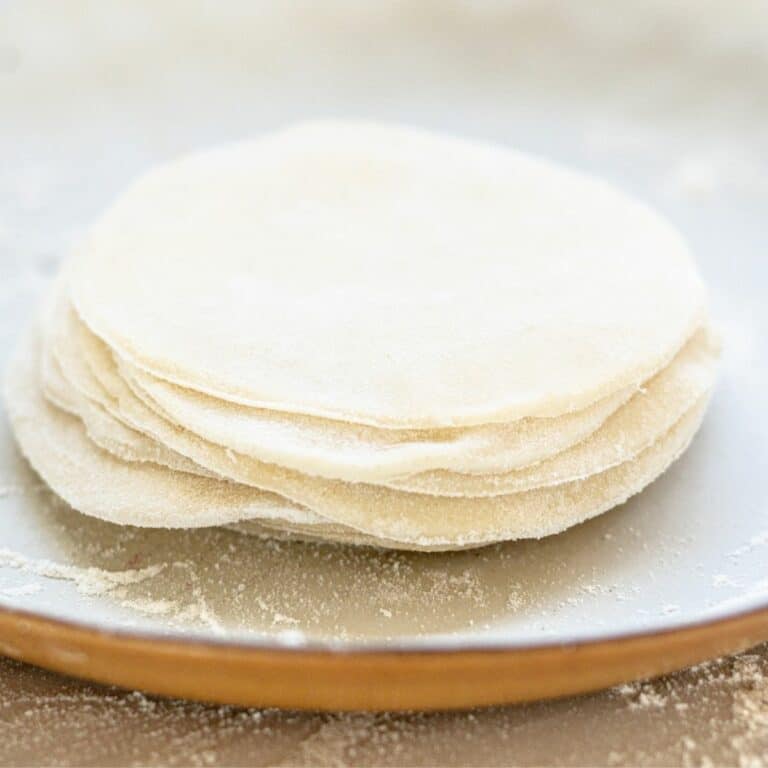





This looks so good. Homemade bread recipes always make me feel overwhelmed, but this looks so achievable with the step by step photos and timelines 💜 It’s also the closest I’ll get to Provence for a while!
Thank you!
I can’t wait to try this!